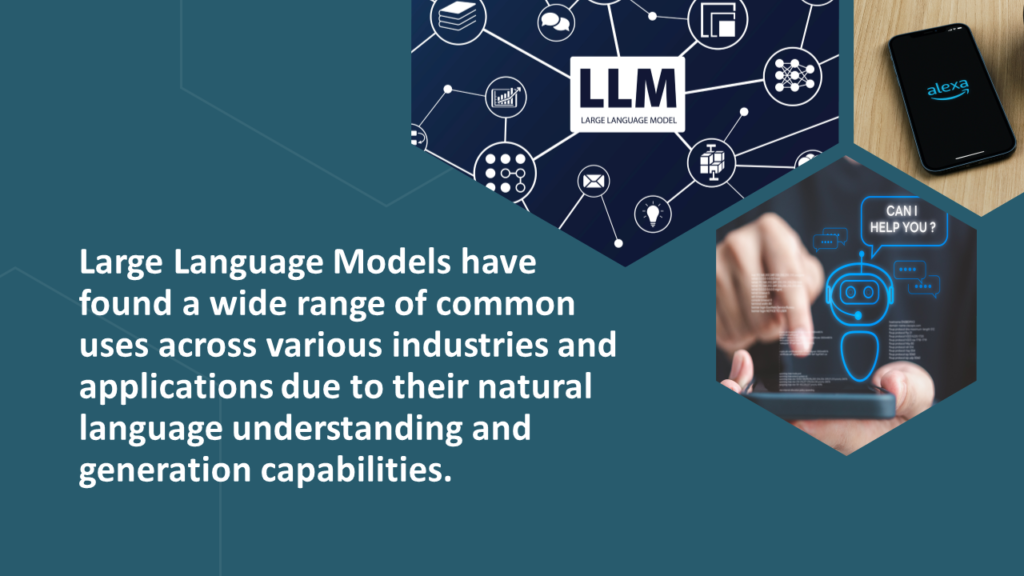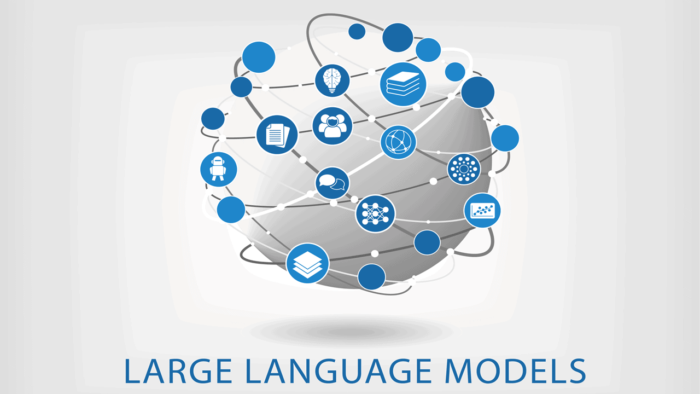What are Large Language Models (LLMs)?
Amidst the dynamic landscape of technology and artificial intelligence, a stand-out game-changer emerges: large language models (LLMs). These remarkable creations have emerged as the veritable Titans of the AI realm, reshaping the way we interact with machines, process information, and communicate in the digital age.
Imagine having a virtual assistant that not only understands your words but comprehends the nuances of your language, a tutor that can provide in-depth explanations on any topic, or a content generator capable of crafting human-like prose. These capabilities are no longer confined to the realm of science fiction; they are the products of large language models, which are transforming the fabric of our digital world.
What are Large Language Models?
Large Language Models, commonly referred to as LLMs, is a type of artificial intelligence (AI) that represents the frontier of what technology can achieve with language. These models are like colossal digital libraries, but instead of just storing information, they understand and generate text. They’re based on neural networks, which are computer systems modeled after the human brain.
These networks “learn” from massive amounts of data. Imagine reading all the books, articles, and websites you’ve ever seen, and then some. LLMs have gone through an equivalent exercise, digesting billions of words to understand patterns, nuances, and complexities of various languages. Their expansive training allows them to be responsive, intuitive, and eerily human-like in their interactions.

How can Large Language Models Can Help in Real Life?
LLMs use deep learning techniques and extremely large datasets to understand and predict new content. In real life, a LLM can actually help anyone with a question related to anything from history, mathematics, literature, coding and more, just like ChatGPT provides answers and solutions to virtually any question you can imagine.
Consider the age-old challenge of homework. Lucy is struggling with a history assignment about ancient civilizations. She turns to an LLM for assistance, asking, “What were the main contributions of the Ancient Egyptians?”
Like a modern-day encyclopedia, the LLM quickly processes her question and responds with a detailed answer, citing the invention of hieroglyphs, advancements in architecture like the pyramids, and innovations in medicine. Lucy didn’t just get a simple reply; she got a mini-lesson, thanks to the LLM’s vast knowledge base and its ability to contextualize and generate relevant content on the fly.
Why are LLMs important?
In the rapidly evolving digital age, information is abundant, but meaningful and instant insights can be elusive. LLMs bridge this gap. They democratize access to knowledge by being available round-the-clock, aiding in education, research, and countless other fields.
Large Language Models (LLMs) are essential and influential in today’s technology landscape for several significant reasons:
Natural Language Understanding and Generation
LLMs can understand and generate human-like text, making them invaluable for a wide range of natural language processing tasks. They can answer questions, write essays, create conversational agents (chatbots), translate languages, and summarize text, among many other applications.
Problem Solving and Decision Support
LLMs can assist with complex problem-solving and decision-making by providing information and insights. They can analyze vast amounts of text data and generate recommendations, helping professionals in various fields such as medicine, law, finance, and research.
Content Creation and Personalization
LLMs can automate content creation at scale, enabling organizations to generate news articles, reports, product descriptions, and more. They also power content personalization, tailoring content to individual preferences, enhancing user experiences, and boosting engagement.
Language Translation
LLMs have revolutionized machine translation, making it possible to translate languages with greater accuracy and fluency. This has opened up opportunities for global communication, business expansion, and cultural exchange.
Accessibility
LLMs can enhance accessibility by providing text-to-speech and speech-to-text capabilities. They can be used to create tools and applications that assist individuals with disabilities, making information more accessible to everyone.
Knowledge Extraction
LLMs can extract valuable information and insights from unstructured text data. This is useful for tasks like sentiment analysis, trend detection, and sentiment monitoring, which can inform businesses and organizations about public perception and sentiment.
Innovative Applications
LLMs serve as a foundation for numerous innovative applications. For example, they are used in virtual assistants like Siri and Alexa, recommendation systems on platforms like Netflix and Amazon, and even in creative tasks like generating art and music.
Efficiency and Automation
LLMs can automate tasks that were previously time-consuming and labor-intensive. This includes tasks like data entry, content generation, and customer support, which can significantly improve operational efficiency and reduce costs.
Research and Development
Language Models are essential tools for researchers in various fields, including linguistics, social sciences, and computer science. They can help analyze large datasets, discover patterns, and gain insights into human language and behavior.
Education and Learning
They can be used as educational tools, providing explanations, answering questions, and offering personalized learning experiences. They can assist students and educators in various subjects, from mathematics to literature.
Data Exploration
LLMs can assist in exploring and understanding large datasets by summarizing, visualizing, and providing context to data. This aids in data analysis and decision-making in fields like data science and analytics.
Multilingual Communication
Models support multilingual communication, breaking down language barriers and facilitating cross-cultural collaboration, trade, and diplomacy.
Continuous Improvement
LLMs are continually evolving and improving. Researchers and developers work on refining models, reducing biases, and enhancing their capabilities, ensuring that they remain relevant and useful in an ever-changing technological landscape.
However, it’s worth noting that LLMs also come with challenges and ethical considerations, such as bias in language generation, privacy concerns, and potential misuse. Addressing these issues responsibly is essential to maximize the benefits of LLMs while minimizing their risks.

Common Uses of LLMs
Large Language Models have found a wide range of common uses across various industries and applications due to their natural language understanding and generation capabilities.
- Text Generation and Content Creation: LLMs can generate human-like text for a variety of purposes, including writing articles, blog posts, product descriptions, marketing content, and creative writing.
- Chatbots and Virtual Assistants: LLMs power chatbots and virtual assistants that can engage in natural language conversations, answer questions, provide information, and offer customer support.
- Translation Services: LLMs excel at machine translation, enabling the translation of text between multiple languages with improved accuracy and fluency.
- Question Answering Systems: LLMs are used in question answering systems that can provide detailed responses to user queries, making them valuable for search engines and information retrieval.
- Text Summarization: LLMs can automatically generate concise and coherent summaries of long articles, documents, or news stories, making it easier for users to extract key information.
- Sentiment Analysis: LLMs are employed for sentiment analysis to determine the emotional tone of text, which is useful for understanding customer feedback, social media monitoring, and market research.
- Content Recommendation: Platforms like Netflix, Amazon, and YouTube use LLMs to recommend content to users based on their viewing or browsing history, enhancing user engagement.
- Language Modeling: LLMs serve as the foundation for various language models, including text prediction, auto-completion, and next-word prediction features in text editors and messaging apps.
- Text Classification: LLMs can classify text into categories, which is valuable for spam detection, content moderation, and organizing information.
- Voice Assistants: LLMs are integrated into voice assistants like Siri, Alexa, and Google Assistant to provide voice-based responses and perform tasks based on voice commands.
- Data Extraction: LLMs are used for information extraction from unstructured text data, such as documents, invoices, or forms.
- Coding Assistance: LLMs provide coding assistance by suggesting code snippets, fixing syntax errors, and offering programming-related information, making them useful for developers.
- Medical and Scientific Research: LLMs assist researchers in analyzing scientific literature, generating research papers, and answering domain-specific questions in fields like medicine and biology.
- Personalized Marketing: LLMs help in personalizing marketing campaigns by generating tailored content and recommendations based on user preferences and behavior.
- Content Moderation: LLMs aid in content moderation on social media platforms and websites by identifying and flagging inappropriate or harmful content.
- Legal and Compliance: LLMs are used in the legal industry for document review, contract analysis, and compliance monitoring, improving efficiency and accuracy.
- Education: LLMs can provide educational support by answering student questions, generating study materials, and offering explanations on various subjects.
- Knowledge Management: Organizations use LLMs to automate knowledge management processes, extract insights from internal documents, and improve information retrieval.
- Generating Code Documentation: LLMs can automatically generate documentation for software code, making it easier for developers to understand and maintain their codebases.
- Conversational AI in Healthcare: LLMs are employed in healthcare for building conversational AI systems that assist patients with medical queries, appointment scheduling, and symptom checking.
These common uses of Language Models highlight their versatility and the transformative impact they have had on industries. As LLMs continue to evolve, their applications will likely expand even further, opening up new possibilities for human-computer interaction and automation.
When are LLMs used?
The beauty of LLMs is their round-the-clock availability. Whether it’s a student burning the midnight oil, a researcher in a different time zone, or a writer seeking inspiration during the wee hours, LLMs are always at the ready. They shine particularly when timely responses are crucial. For businesses, this could mean offering immediate assistance to customers; for learners, it might be the difference between understanding a challenging concept or not.
How do LLMs relate to software development?
In the realm of software development, LLMs are transformative. Developers can integrate LLMs to make their applications more intuitive and responsive. For instance, an app designed to help writers could use an LLM to offer suggestions, correct grammar, or even predict what the writer intends to type next. Beyond just user interface, LLMs can help developers parse through user feedback, identify trends, and improve software based on user interactions. They elevate software from being mere tools to interactive companions that adapt and grow with the user.
Large language models play a multifaceted role in software development, from assisting in code generation and analysis to improving user interfaces and supporting various aspects of the development lifecycle. As these models continue to advance, they are likely to become even more integrated into the daily workflows of software development projects, enhancing productivity and software quality.
i3solutions and LLMs
Harnessing the power of LLMs requires expertise, and that’s where i3solutions shines. With their hands-on experience in integrating LLMs into various projects, we understand the nuances and potential pitfalls. We are experts at guiding projects from the ideation stage, ensuring that the integration of LLMs enhances, rather than overwhelms, the end product. With a track record of successful deployments, partnering with i3solutions means ensuring that the vast potential of LLMs is harnessed effectively for your project’s success.
Contact i3solutions today to discuss how large language models can elevate your business.
Leave a Comment


